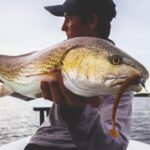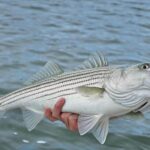
Guide to Draft Addendum II for Atlantic Red Drum Management
This guide is meant to educate anglers, conservationists, and the public about the Atlantic States
The American Saltwater Guides Association might be governed by guides but since our beginning, we have tried to represent all voices in conservation. Our Chairman is a tackle shop owner. We are a resource for private rec anglers.
Our tag line is “Better Business Though Marine Conservation”. Essentially, the more fish we have in the water, the better it is for all. We aren’t interested in picking winners. We are interested in resource first management.
ASGA has gotten a lot of criticism over our position for managing for abundance. Sounds crazy but apparently the term scares some people. It is hard to quantify what “abundance” means.
We did some poking around in the fisheries databases and the numbers explain what we mean by managing for abundance. When striped bass stocks are good, directed angler trips are staggering. When the stocks start to falter, there is a ripple effect in effort.
Let’s take a look at Maryland and New Jersey with a baseline years of 2015 and 2019. We selected those two years because of the abundant 2011 year class. At four years old, those fish became legal size in the Chesapeake and were fun targets in New Jersey.
Since these fish had not reached spawning age by 2015, they are not part of the Spawning Stock Biomass chart that we use to estimate the striped bass population. However, they were out there and anglers took advantage of the action. In the case of New Jersey, these fish weren’t legal even with the bonus tag.
In 2015, Maryland recreational anglers took 2.87 million trips with striped bass being the primary target. That is a lot of fishing! The massive 2011 year class provided anglers and incredible opportunity to be successful. It was easy fishing. The average angler who takes a few trips a year could go out and have consistent action. That drove participation which in turn drives the economy. Hotels, restaurants, tackle shops, and countless other small businesses benefited from mother nature’s gift (Near perfect spawning conditions for the 2011 fish).
Let’s move to 2019 in Maryland. The young of the year for 2012 was the worst ever recorded. 2015 was a good class but 2013, 2014, 2016, and 2019 were all below average. Some were really bad, not even close to average.

Can you guess what the directed trips number looked like in 2019? What was left of the 2011 year class had moved out of the bay to become part of the coastal stock. Not much was there to replace them.
There were only 1.499 million trips in 2019. That’s a 48% reduction in effort. That’s over 1.3 million trips not taken. So, how much gas, how many sandwiches, how many motor tune ups, how much gear, and how much did Maryland lose in tax revenue on marine fuel alone?
New Jersey is experiencing the same trend. In 2015, New Jersey recreational anglers took 4.297 million directed trips for striped bass. Understand that the 2011’s were not legal to harvest. Yet, New Jersey anglers went out in force. They knew that they would catch something and for most anglers, that knowledge is enough to get them out on the water.
In 2019, there were 2.777 million directed trips taken. That is a 34% drop in effort but a staggering 1.527 million trips not taken. The 2011 year class did not recruit to the coastal stock in the numbers that were predicted. As we chipped away at the 2011’s, the opportunity to have some action also dropped.
Maryland and New Jersey believe that harvest drives participation. We disagree. Abundant populations drive trips. We have seen it over and over again yet it is being ignored.
In a coast-wide time series, the same narrative plays out. In 2006 during the peak abundance, we had 25 million trips where striped bass were the primary targets. In 2012, when we all started seeing a decline, there were 22 million trips taken. In 2019, we are sitting at 15 million. That’s 10 million directed trips not being taken by rec anglers. The one metric that stands out is not the amount of fish that could be harvested but the amount of fish in the water.
When you have an economic driver that provides this amount of activity, shouldn’t it be protected? These numbers clearly show that the more stripers that are out there, the better all the small businesses will do. Right now, we have lost 10 million trips a year since the peak. What will happen if the reference points are lowered during the upcoming amendment process? If you own a small business that depends on striped bass fishing, you should be very concerned.
We can’t explain why ASMFC doesn’t see this. We aren’t even going to offer a guess. However, we are here to advocate for you and striped bass. Let’s fix this mess together.

This guide is meant to educate anglers, conservationists, and the public about the Atlantic States

Imagery Courtesy of Sean Cobelli Media We encourage anglers, guides and conservationists to use this

Last week, the Florida Fish and Wildlife Conservation Commission (FWC) hosted the 2025 Sea Trout Symposium.

Photo Credit: Guiding Flow TV The fishing industry has lost an icon. The family and
We rely on our members and donations to keep fighting for a sustainable tomorrow in marine conservation.
GIVE THE GIFT OF FISHERIES CONSERVATION THIS HOLIDAY SEASON. SHOP ASGA GOODS THAT FUND FISHERIES RESEARCH & ADVOCACY CAMPAIGNS
JOIN ASGA IN CALLING FOR CRITICAL MANAGEMENT ACTION AFTER YEARS OF SPAWN FAILURES & POOR MANAGEMENT.
By using this website, you agree to our use of cookies. We use cookies to provide you with a great experience and to help our website run effectively. To learn more, please review our privacy policy.
3 Responses
Just shut it down on the whole east coast. Follow N.C’s lead. Also of now they have a 2 year moritorium.
Well said! Abundance drives the tackle industry and gets anglers on the water and young anglers engaged in the Sport. An angler needs a reasonable expectation of catching a fish to invest the time and energy to go fishing. It’s clear that as fish populations decrease, the effort to catch one increases and the number of trips decrease. Let’s get back to an abundant stock and make sure the ASMFC doesn’t try and change the reference points defining how many fish are going to be in the water. Remember the reference points that are in place today were put into place after the crash of the fishery and the striped bass came back and fishing rebounded, businesses flourished and the tackle industry was healthy.